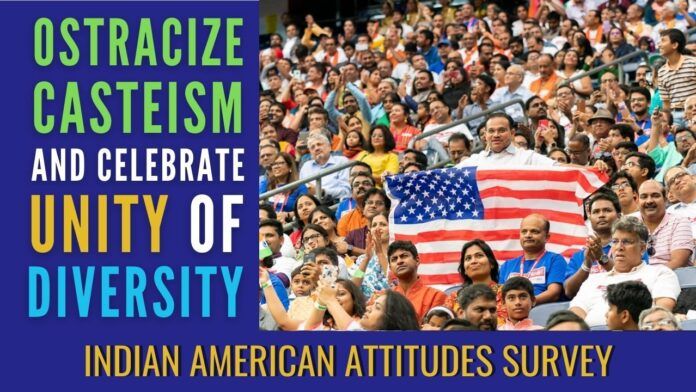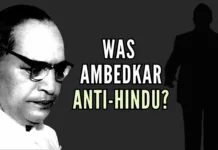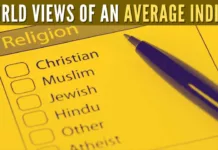
2020 Indian American Attitudes Survey
A recent report based on a survey of 1200 Indian Americans (IA), titled, “2020 Indian American Attitudes Survey (IAAS),” is a landmark study that at last distinguishes IAs from the broader “South Asian” group. The authors have asked well-thought-out questions to elicit IA’s social, political, economic, religious, and cultural attributes and attitudes. It is significant that the IAs constitute a powerhouse in almost all sectors such as the corporate, government, universities, medicine, technology, etc. While the IA’s have made good on the promise of living an American dream, the study appropriately concludes, “… there are also nascent signs that these common bonds are being tested as religious cleavages, generational divides, and political polarization invite fragmentation.”[1]
Among others, the IAAS study touches on one of the most contentious, controversial, and conspiratorial subjects of “caste,” the subject of this article. The cast, as we know, is a highly political and polarizing issue in India. But it is beyond my comprehension why anyone should talk and promote rather than ostracize it in the American system?
While the IAAS had good intentions and intellectual mission of eliciting answers to many questions, it opened a can of worms by including only the self-identified Hindus to ask about their association with caste.
Living in the U.S for more than 40 years and a naturalized citizen, my conversation about “caste” has been minimal to non-existent in the American context and culture. It is my observation that caste is no longer a hot topic in India except when the election politics get heated. According to ancient literature, the Varna system is based on occupation. On the other hand, jāti (caste) refers to the thousands of endogamous groups prevalent across the subcontinent. For transparency, I am a Vaishya in the current caste system but a Brahmin according to the varna system because of my occupation (a higher education professional). Above all, I am a proud Hindu and a human being. Also, I was not a respondent for IAAS.
The caste in the U.S. was a non-topic until the highly polarizing, “ Caste in America” series, a highly misconstrued survey by the Equality Labs, a lawsuit alleging caste-based discrimination, and efforts in California and elsewhere surfaced in the recent years.[2] Collectively, select IA’s, aided by Hinduphobic groups, are obsessed to have the Hindu IAs relive the unpleasant “casteism” in the U.S. The Equality Labs, founded by a disgruntled IA but a Missionary by deeds, has promoted more inequalities and done the most damage by perpetuating the narrative that caste is associated with Hinduism which it is not. Fortunately, the IAAS objective study finally discredited the 2018 survey of the Equality Labs. It is unfortunate that many IAs still embrace the caste status in America and use it to gain notoriety at the cost of abandoning the powerful unity in diversity.[3]
While the IAAS had good intentions and intellectual mission of eliciting answers to many questions, it opened a can of worms by including only the self-identified Hindus to ask about their association with caste. Why not all IAs and not even a footnote about the varna and jati (caste) being very different concepts. We know that the latter was perpetuated negatively by the evil colonizers who cleverly imposed on Indians and conspired to associate it with Hinduism. The author of a recent book, Caste, Conversion, A Colonial Conspiracy (published before the IAAS report) summarizes eloquently, “Almost everyone on the planet has heard of the “Ancient Hindu Caste” system and somehow, almost everyone knows how horrible it is, but what if it wasn’t ancient and it wasn’t Hindu?”[4]
Clearly, there is no ancient Hindu caste, yet the IAAS report cared not to even add a footnote about the book or other historical evidence. A validation of ‘Hindu caste’ by excluding non-Hindus in IAAS is a disservice and academic shortsightedness. I argue that the IA’s born and raised here deserved to know about the missed history of how our forefathers had devised varna and jati for many environmental and cultural reasons at the time, but by no means, it was rooted in discriminatory practices.
In my informed view, IAAS should have informed the potential readers that “caste,” as portrayed in the U.S., has many faces- the good, bad, and ugly.
With due respect for, “work is worship,” the so-called menial jobs were and are still done by people of all faith. For example, my wife’s household in India had a Muslim lady cleaning the toilets. In my village, there were/are many Muslim Shudras (in varna system) who are now characterized as SC, ST, and/or OBC under the highly politicized India’s complex caste classification. They are serving as artisans, plumbers, carpenters, potters, farm laborers, etc. The IAAS framers should have posed a more open-ended question to all 1200 survey respondents and not just Hindus who eschewed the survey results.[5]
Let us analyze the survey findings further. Among the Hindus (632 respondents), only less than half (47%) identified with a caste. Of these, more than half (57%) were born in a foreign land. This means that the caste association relates to only about 155 self-identified Hindu immigrants, merely 13% of 1200 survey respondents in IAAS. It is a huge, missed opportunity for IAAS because most first-generation IAs, irrespective of their stated faith, had exposure to the caste-ridden system of independent India in addition to the divisive politics based on religion and region, etc. A granular study of the relationship between caste and religion; knowing if the concept of caste is prevalent among people of all religions, and how has it affected them in the United States will be a welcome step in the future IAAS study.
In my informed view, IAAS should have informed the potential readers that “caste,” as portrayed in the U.S., has many faces- the good, bad, and ugly. The good- its origin in the ancient varna system based on occupation (skills, interest, and societal needs), the bad is its mischaracterization as “ancient Hindu caste” during British empire, and the ugly when independent India’s leaders and “brown” sahibs created the caste-based “quota” system for employment and education opportunities. India was on the right path to devising ways to create “equality of opportunity” and offer incentives and encouragement for those who were grossly neglected. Regrettably, the caste-based quota system of modern India has become extremely political, highly divisive, and took the turn for the worse. Casteism is now used as a vote bank by every political party. It is so pervasive that no matter who holds the leadership, it is “suicidal” to withdraw the caste-based privileges from those who have them and to deny them to others who are constantly asking for them.
One of the unintended consequences of the IAAS report is people identifying that they belong to the “upper” caste, OBC, and another category, a dangerous path forward among the IA’s. The upper cast, as I interpret it, includes the people of three varnas (Vaishya, Brahmin, and Kshatriyas) with the remainder being lower caste. It is the ugly part of a totally man-made concept dividing people into a “class” system based on socio-economic status which exists almost universally. I seriously question the IAAS’s intent in perpetuating the upper and lower caste versions even as an academic exercise.
The IAAS study also asked respondents whether, in the last twelve months, they have personally felt discriminated against. The aperture of the study went beyond the country of origin. It included skin color, gender, religion, and caste. Interestingly, only 5% of all respondents reported having encountered discrimination due to their caste identity; a vindication that the alleged Hindu caste system does not discriminate based on caste. This finding, one hopes, would play a decisive role in the dismissal of alleged caste-based discrimination which otherwise has the potential to pit a select group of IAs against other IAs going forward. Let me add one more observation that 39% of IA Muslims reported the greatest degree of religious discrimination. It is a symptom that frightens me most that Hinduphobic individuals and/or groups may initiate litigations pitting IAs of one faith against the IAs of another faith. While I understand the academic nature of the scholarship behind IAAS, it might be a roadmap for controversies and conspiracies of the future.
Finally, a word about the Indian Americans’ identity in the survey. They are mostly born in India or have hereditary roots in India, but all live in America. It is therefore important to conclude by bringing cultural and social aspects of both India and the U.S. as it relates to caste.
I am afraid that the casteism and associated vote bank politics in India is going to get worse before getting better. Getting worse means that the people without the current caste-based reservation “quota” may agitate similar to Patels in Gujarat but denied in the court of law. I hope that either the legal system or a strong-willed future leader withdraws the caste-based incentives from families who have availed it in one generation. For example, a child in a family with respected socio-economic status due to the caste-based incentives must not be given employment, education, and other benefits earmarked for a weaker section of society.
Advice to the IA’s; please stop dividing yourself based on the caste in addition to the religion, region, language, food, where and how frequently you worship, what and how you celebrate your culture/festivals? There are perhaps more categories/reasons than I can list which divide the IAs and create a wedge between IA’s and the culture and country we call home. The IA’s owe and must help America embrace unity in diversity and ostracize all things about caste. We must rather promote, “All people born equal,” and “Vasudeva kutumbakam,” the world is one family. Why perpetuate more hatred and division based on our diversity of color, caste, creed, and culture, just to name a few?
In conclusion, the authors of landmark IAAS deserve commendation for the first objective study of attitudes and attributes. While the caste-based questions asked of only Hindus in IAAS were not the best choice, it is an easy target for criticism in the hindsight. More importantly, any scholarly work, I believe and hope, is a step forward for deeper, granular, and more inclusive studies without expanding the unwanted and unwarranted controversies.
Note:
1. Text in Blue points to additional data on the topic.
2. The views expressed here are those of the author and do not necessarily represent or reflect the views of PGurus.
References:
[1] Social Realities of Indian Americans: Results From the 2020 Indian American Attitudes Survey. – Jun 09, 2021, Carnegieendowment
[2] Caste in America.– Jun 28, 2021, PRI
[3] CASTE IN THE UNITED STATES.– Equalitylabs
[4] Caste, Conversion A Colonial Conspiracy: What Every Hindu and Christian must know about Caste.– Feb 11, 2021, Amazon
[5] What is India’s caste system?– Jun 19, 2019, BBC
- Education and election in Bharat: Race to the top - April 16, 2024
- Kejriwal: “An Insignificant Man” or a corrupt politician with impending prison term - March 24, 2024
- Bharat’s general elections and the Model Code of Conduct - March 22, 2024











[…] men, women, or animals?As the Dismantling Hindutva Conference with its violent imagery and ties to Equality Labs continues its tirade against Hindus, Swami Vivekananda’s words echo in the USA again.Just as […]
Dear Vijendri ji,
Thank you very much for this fact based article. Keep such article coming.
I have been working on the Verna system for a few years now, that is not caste. Verna system is critically important for the prosperity and harmony of a society and organization. Please listen to my talk, “Turning the Shudra Around: For satisfied individual, successful organization, and prosperous society.” at the International Conference on “Sri Aurobindo and India’s Renaissance.” by @IndianInstituteofAdvancedStudy, @RashtramSchool, @Rishihood University:
https://www.facebook.com/poonam.gupta2/posts/10158778631777620?notif_id=1628775333741117¬if_t=feedback_reaction_generic&ref=notif